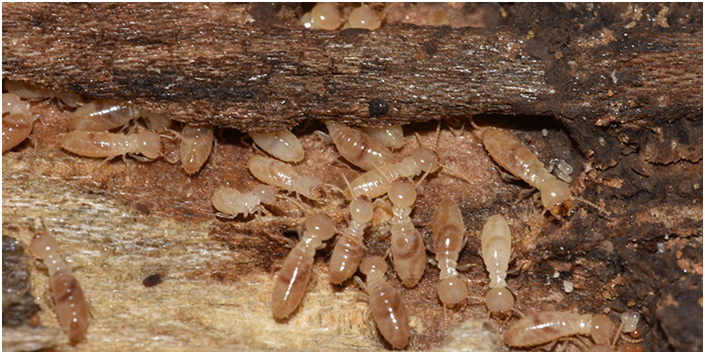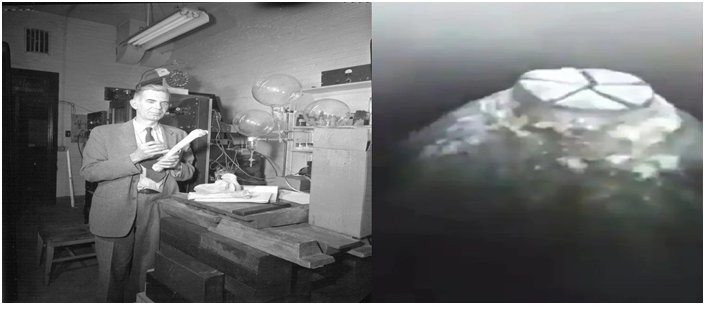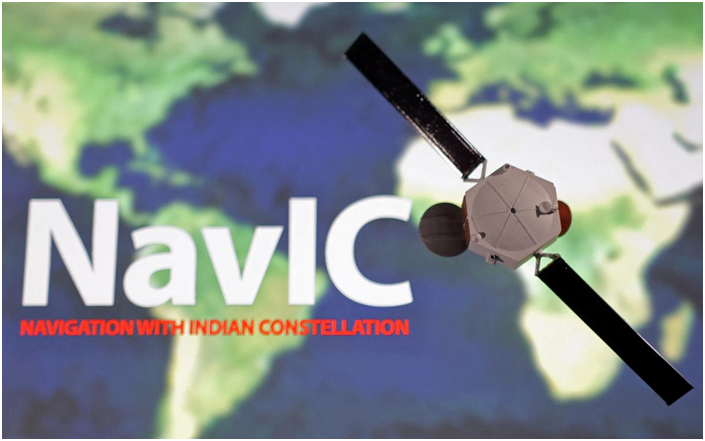Global warming increased appetite of termites: Study (GS Paper 3, Environment)

Why in news?
- Global warming has introduced an unusual new player in Planet Earth’s carbon cycle — termites: Their appetite for carbon-storing wood has increased, according to a recent study.
- The wood biomass consumption of these insects has increased more than 6.8 times for every 10 degrees Celsius rise.
- The Isoptera sp. release carbon dioxide by decaying deadwood, dead parts of a tree.
Details:
- An international team of scientists studied how climate influenced the decomposing activity of termites. They also included microbes, which are also known to feed on deadwood.
- Previous regional studies showed microbe-driven wood decay almost doubled with a 10°C temperature increase.
- The role of termites in the global carbon cycle is often overlooked. Not much is known about their climate sensitivity.
Basis of Research:
- So, researchers studied 133 sites across Asia, Africa, Europe, North America, South America and Australia. This includes 20 countries with equal numbers in the northern and southern hemispheres and tropical and temperate regions.
- At each site, researchers recorded how termites and microbes decayed the wood of Pinus species for up to 48 months.
Key Findings:
- Termites were discovering or seeking more food in arid and semiarid sites than in humid sites and sites with moderate moisture levels.
- Microbial-driven decay was fastest at low latitudes and elevations where temperatures and precipitation are high, the results showed. As for termites, decay rates were higher at low elevations and high-temperature regions.
- Termites were more sensitive to temperature changes than microbes.
- The researchers think termites’ increased appetite can be explained by the fact that these social insects are ectothermic. Their body temperature is regulated by external sources such as sunlight.
- The activity of decay enzymes in their guts relies on temperature. There are other possibilities such as the number of termites or particular species of termites increasing in warm places.
Fungus-growing termites:
- The researchers, however, think that they could be underpredicting termite effects in Africa and Asia, home to fungus-growing termites.
- These termites act as farmers, growing white rot fungi. These organisms are known to break down lignin –the second most common carbon compound in wood and are also hardy.
- The termites relegate their wood decomposition work to rot fungi.
Way Forward:
- In the future, termites will likely expand their range in a warming world. And this could have important consequences for carbon cycling.
- Climate models predicted an expansion of termite discovery in tropical and subtropical regions under all warming scenarios, with most impacts felt in high warming scenarios.
Seeking minors confession of crime unconstitutional
(GS Paper 2, Polity and Governance)
Why in news?
- Seeking a confession about an alleged crime committed by a juvenile is unconstitutional as a “presumption is raised at the pre-trial stage itself that the child has committed the offence, the Delhi High Court has said.

What was the case before HC?
- The High Court was hearing a criminal reference relating to the issuance of guidelines to be followed by Juvenile Justice Boards (JJB) in conducting preliminary assessments before sending a minor for trial as an adult.
- It had earlier allowed a plea by NGO HAQ Centre for Child Rights to intervene in the matter.
Highlights of the judgement:
- A bench of Justices which perused a preliminary assessment report prepared by a psychologist on the subject, said that under clause 3 of the report it can be clearly noted that a confession is sought to be extracted from a child as to how the offence was committed and the reasons thereof.
- This manner of seeking a confession from the child is unconstitutional and beyond the scope of a report of the preliminary assessment to be prepared under Section 15 of the JJ Act.
JJ Act on preliminary assessment:
- Section 15 of the JJ Act provides that in case a child, between 16 to 18 years of age, has committed a heinous offence, the Juvenile Justice Board may conduct a preliminary assessment to assess the maturity level of the child, his mental and his physical capacity to conduct such an act.
- Under the Act, the probation officer is required to fill out a form that relates to the preparation of the Social Investigation Report (SIR) for children in conflict with the law.
- The bench said the two questions regarding the alleged role of the child and reason for committing the offence were incorrect as a presumption is raised at the pre-trial stage itself that the child has committed the offence.
- Most often, this SIR filled by the probation officer is also considered pertinent at the time of preparing the preliminary assessment report under Section 15 of the Act, it said.
Purpose of preliminary enquiry:
- Initially, all children below the age of 18 years were to be treated as a juvenile and tried by the JJB.
- However, after an amendment was brought in the 2015 JJ Act, a separate category for juveniles between the age of 16 to 18 years involved in heinous crimes, was formed.
- A preliminary enquiry needs to be carried out to ascertain if they are to be tried as a child or as an adult.
Gyanvapi mosque case & carbon dating
(GS Paper 3, Science and Tech)
Why in news?
- Recently, the district court in Varanasi on Thursday (September 22) allowed a petition seeking carbon dating of the structure inside the Gyanvapi mosque that the Hindu side has claimed is a ‘Shivling’.
- The court has issued notices to other parties wanting to know whether they have any objection to carbon dating.

Background:
- Earlier, the court had rejected the plea of the Gyanvapi mosque management questioning the maintainability of the case filed by five Hindu women, seeking permission to worship the idols of Shringar Gauri on the outer wall of the masjid complex.
- The Gyanvapi mosque management committee maintains that the structure in question is a part of the fountain system of the ‘wazu khana’, a small reservoir used by Muslims to perform ablutions before offering namaz.
What is carbon dating?
- Developed by American chemist Willard Libby in 1946, carbon dating is a method used to determine the age of matter that was once living.
- Carbon dating is a widely-used method applied to establish the age of organic material, things that were once living. Living things have carbon in them in various forms.
- The dating method makes use of the fact that a particular isotope of carbon called C-14, with an atomic mass of 14, is radioactive, and decays at a rate that is well known.
- The most abundant isotope of carbon in the atmosphere is carbon-12 or a carbon atom whose atomic mass is 12. A very small amount of carbon-14 is also present. The ratio of carbon-12 to carbon-14 in the atmosphere is almost static, and is known.
- Plants get their carbon through the process of photosynthesis, while animals get it mainly through food. Because plants and animals get their carbon from the atmosphere, they too acquire carbon-12 and carbon-14 isotopes in roughly the same proportion as is available in the atmosphere.
- But when they die, the interactions with the atmosphere stops. There is no further intake of carbon.
Half-life:
- Now, carbon-12 is stable and does not decay, while carbon-14 is radioactive. Carbon-14 reduces to one-half of itself in about 5,730 years. This is what is known as its ‘half-life’.
- So, after a plant or animal dies, the ratio of carbon-12 to carbon-14 in the body, or its remains, begins to change. This change can be measured and can be used to deduce the approximate time when the organism died.
Can it be used to determine the age of non-living this?
- It is not used to ascertain the age of non-living things like rocks, stones, etc.
- There are other methods applied to calculate the age of non-living objects.
- Also, the age of things that are more than 40,000-50,000 years cannot be arrived at through carbon dating.
- This is because after eight to ten cycles of half-lives have been crossed, the amount of carbon-14 becomes almost negligible and undetectable.
- But carbon dating can be used indirectly to date rocks if they have any organic material such as dead plants or insects attached to them.Those dead organisms can help in deciding when that inanimate object reached that place.
- For example, the age of the ice cores in glaciers and polar regions is determined using carbon dating by studying the carbon dioxide molecules trapped inside large ice sheets. The trapped molecules have no interaction with the outside atmosphere and are found in the same state as when they were trapped.
Other methods:
- How long a rock has been at a particular place can also be determined using similar indirect methods. If there are organic materials, dead plants or insects trapped beneath the rock, they can give an indication of when that rock, or any other thing, had reached that place.
- There are various other methods to date sedimentation around an object, for example, that are used depending on the specific situation.
- In the Gyanvapi case, the petitioners want to establish that the ‘Shivling’ existed in its place much before themosque came into being. Ascertaining that is theoretically possible.
Can carbon dating be used in the Gyanvapi case?
- It remains unclear if carbon dating is a suitable method to determine that the structure, which the Hindu side claims is a ‘shivling’, existed much before the mosque was built in 1669.
- One of the methods of carbon dating requires examining trapped organic material beneath the structure which would involve uprooting it. In such a scenario, this method might not be a feasible option.
ISRO develops artificial smart limb to aid amputees
(GS Paper 3, Science and Tech)
Why in news?
- The India Space Research Organisation (ISRO) has developed an artificial smart limb that could help amputees in walking with a comfortable gait.
- The artificial limb is a spin-off from space technology that could be manufactured for commercial use soon. The smart is expected to be cheaper by about ten times.

Microprocessor-Controlled Knees (MPKs):
- The newly announced smart tech is called Microprocessor-Controlled Knees (MPKs), which offers extended capabilities for the amputee more than those offered by the passive limbs that do not use the microprocessors.
- Nearly 1.6 kilograms in weight, the smart limb under development, at the moment, enabled an amputee to walk about 100 meters in the corridor with minimum support.
Developers:
- These smart MPKs are being developed by Vikram Sarabhai Space Centre (VSSC), ISRO under an MoU with the National Institute for Locomotor Disabilities (NILD), Pt. Deendayal Upadhyaya National Institute for Persons with Physical Disabilities, and the Artificial Limb Manufacturing Corporation of India (ALIMCO).
How MPKs work?
- The smart limb consists of a microprocessor, hydraulic damper, load & knee angle sensors, composite knee-case, Li-ion battery, electrical harness, and interface elements.
- It detects the state of gait based on the sensor data and the control software estimates the real-time damping needed to attain the desired gait by changing the stiffness of the system.
- The proof of concept model of the limb was developed in an aluminum knee case, a solenoid valve-based damper, and a six-axis load cell, which then went on to use DC motor-based damper with a spool position sensor, pylon integrated load cell, miniaturized control electronics, and a Graphical user interface for parameter tuning in the next phase.
- Walking parameters specific to amputees can be set using PC-based software to improve one’s comfort. The interface plots the parameters in real-time during walking. The feasibility of the design was verified using an engineering model.
What’s next?
- ISRO tested the technology with an amputee after attaining clearance from the Joint Project Monitoring Committee for conducting walking trials.
- The new technology is estimated to be priced at Rs 4-5 lakh, while the currently available limbs are priced at Rs 10-60 lakh.





